When Will Hale Bopp Comet Be Visible on Earth Again
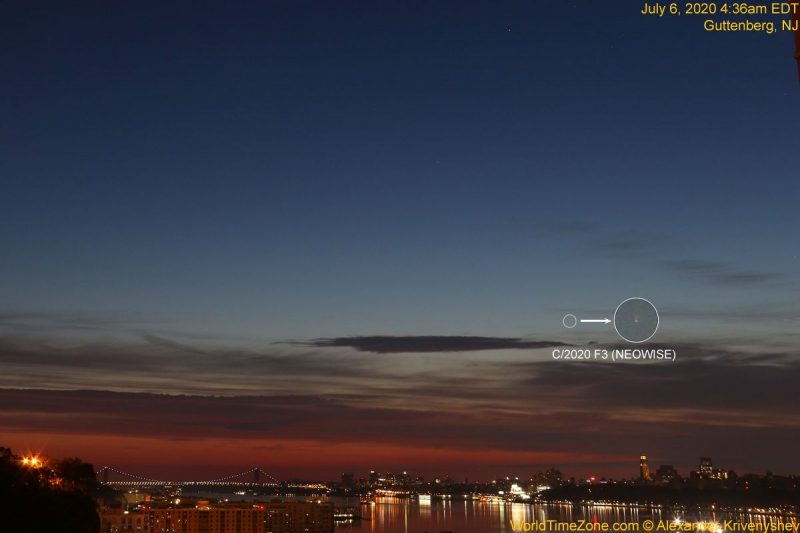
We're now treated to a near-abiding barrage of wonderful comet photos – including those coming in this week of comet C/2020 F3 (NEOWISE). Most are from experienced astrophotographers, almost with excellent skies, employing telescopes and modern cameras and sometimes afterwards creating composites of several images. Nosotros now sometimes encounter comet images from the International Space Station, too. Meanwhile, from the footing and with the eye alone? Yes, NEOWISE is a nice comet. But most will need binoculars to see information technology. The last two great comets – which were McNaught in 2007 and Lovejoy in 2011 – were mainly seen under Southern Hemisphere skies. Not since Unhurt-Bopp in 1996-97 has the Northern Hemisphere seen a magnificent comet.
What's more, some skygazers wouldn't even classify Hale-Bopp as a bully comet. In that case, we in the Northern Hemisphere might have to wait all the manner back to comet West in 1976 – 44 years ago – to find a truly great great comet. When will we encounter the next one?
Permit's consider some of the incredible comets of recent times and historic records, to find out when the Northern and Southern Hemispheres might expect to see the side by side smashing comet.
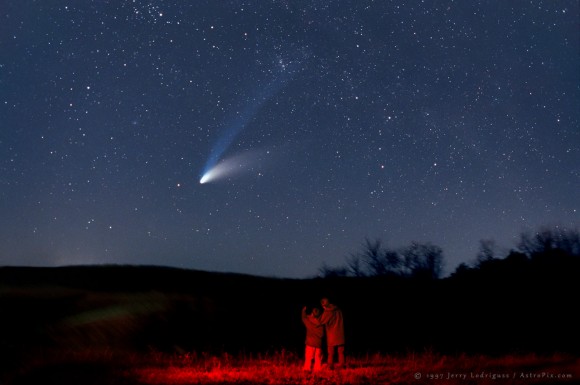
First, how are we defining a bang-up comet? There's no official definition. The label great comet stems from some combination of a comet's brightness, longevity and breadth across the heaven.
For purposes of this article, to consider the question of keen comets of the north and south, and their frequency, we'll define great comets every bit those that accomplish a effulgence equal to the brightest planet Venus (magnitude -3 to -4) or brighter with tails that bridge 30 degrees or more than of heaven.
We can consider some other major comets, too, those that reached magnitude ane or brighter – in other words, they became as bright equally the brightest stars – with tails spanning 15 degrees or more. These major comets would take been visible long enough for Earth's citizenry to take notice (some impressive comets have such farthermost orbits that they aren't visible long, and hardly anyone besides astronomers notices them).
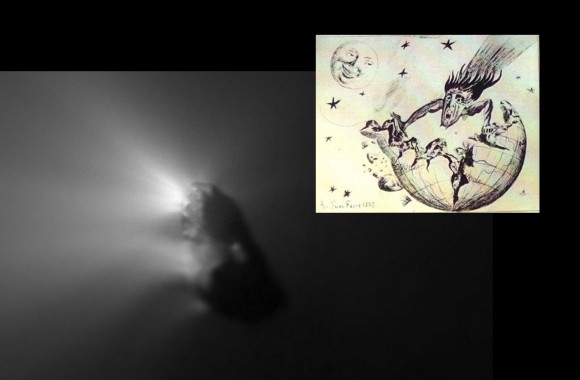
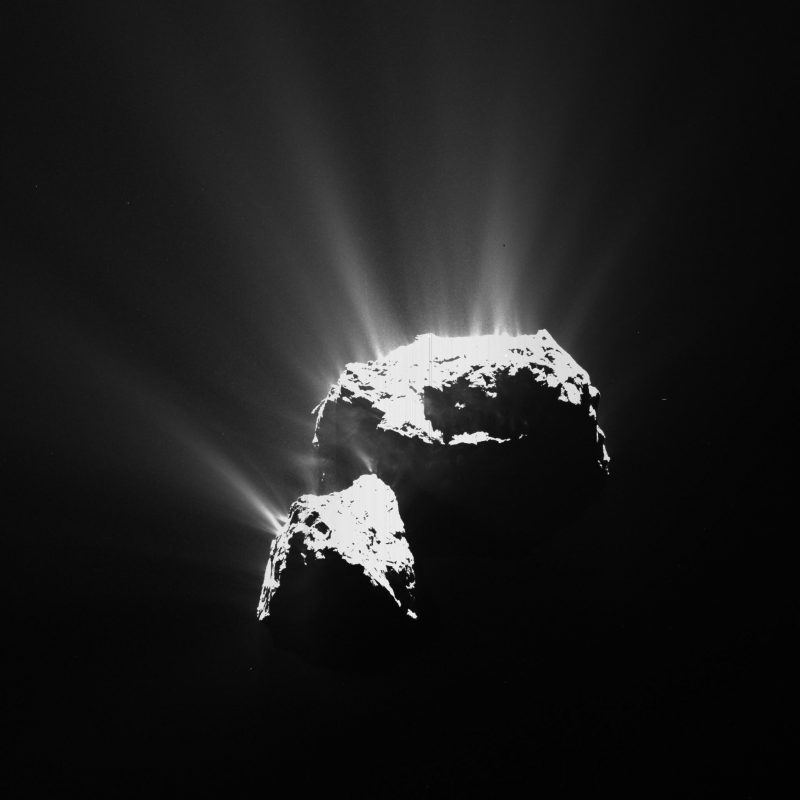
Consider, too, that humanity's ability to view the heavens has completely changed in the last l years.
In that time, infinite travel has become a reality and solid-state electronics have revolutionized photography. Infinite probes have been sent to comets, most recently the European Space Bureau's Rosetta spacecraft, which spent 2 years (2014 to 2016) becoming intimately acquainted with comet 67P/Churyumov–Gerasimenko.
And the transistor and sensitive solid-land detectors revolutionized astrophotography providing amateurs with observing capabilities far exceeding professionals prior to modernistic electronics.
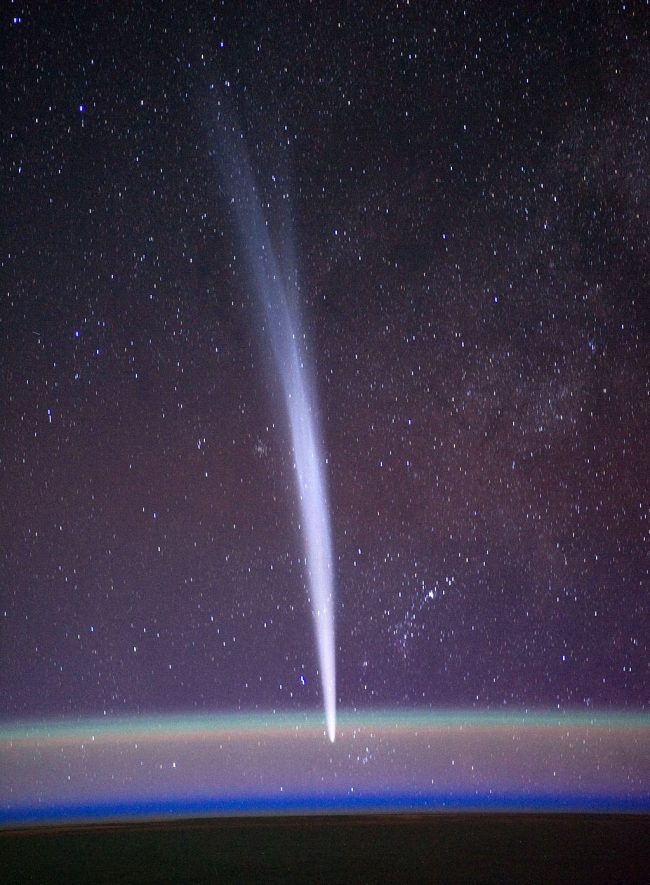
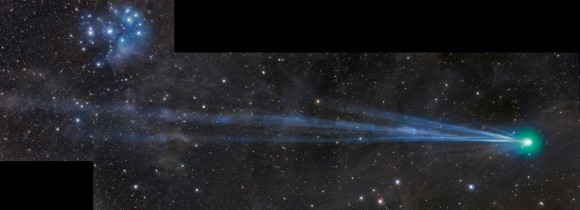
The years 1996-1997 were all about Unhurt-Bopp for comet fans. It was primarily a Northern Hemisphere comet. For weeks on end, Hale-Bopp was a fixture in our western sky, and it probably became 1 of the nigh-viewed comets in history.
This comet was indeed a major comet, but a peachy comet?
Nearly all comets accept short periods of visibility. Unhurt-Bopp literally smashed the previous record for longevity in our skies, which had been held for well-nigh ii centuries past the neat comet of 1811. The 1811 comet remained visible to the unaided centre for nine months. Hale-Bopp was visible for a celebrated 18 months, truly the Cal Ripken Jr. of comets.
Hale-Bopp was vivid early on on, nearly but non quite as bright every bit Venus. The size of its nucleus – the icy core of the comet, hurtling through space – was estimated to exist lx kilometers +/- 20 km (37 miles +/- 12). That makes Hale-Bopp'south nucleus some six times larger than the nucleus of Halley's comet and 20 times that of Rosetta's comet, 67P/Churyumov–Gerasimenko.
Hale-Bopp had a long tail, upward to thirty degrees long, but what was visible and bright was relatively a brusque tail, less than 10 degrees long, for nearly its unabridged period of visibility. Yes, some former great comets did not have 30 degree or longer tails, but those comets were, instead, extremely bright.
Bright generally means as vivid as Venus or brighter. Hale-Bopp was not quite that bright. Some great comets are visible in daylight, only Hale-Bopp was non.
Finally, probably, we have to concede that Hale-Bopp straddles the border of greatness.
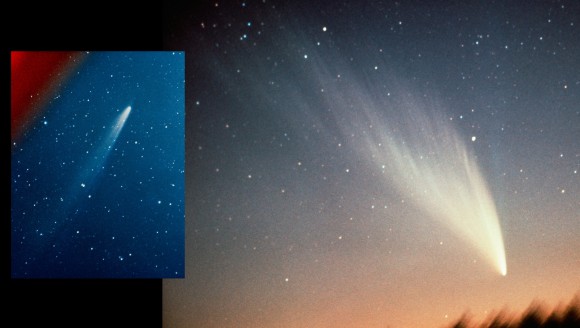
In 1973, skygazers were alerted to the early on discovery of a comet called Kohoutek. At the altitude at which information technology was discovered and its brightness, astronomers projected that this was going to exist a Comet of the Century, perhaps a daylight comet, a one time-in-a-lifetime event.
Merely Kohoutek fizzled. It really disappointed skygazers fifty-fifty though, for professional person astronomers, the drawn-out observations of Kohoutek were quite valuable.
Astronomers thought they had learned a lesson from Kohoutek. Besides many astronomers stood outdoors at public "star parties" that year, trying to show a disappointed public a difficult-to-come across comet.
Unfortunately, the lesson learned from this comet led astronomers to downplay the next contender for greatness: comet West in 1976. That was too bad, because comet Westward did not disappoint. It was a magnificent comet! Still, many average skygazers were left out because astronomers remained repose and the media did not report on it. Thus comet West was not seen and appreciated as it should have been.
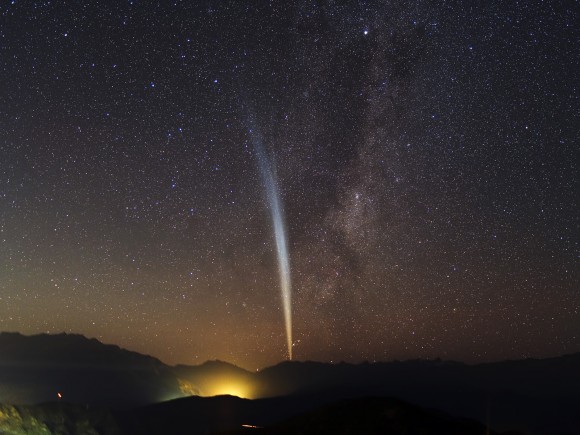
From comet W, fast forwards a full 31 years to 2007 and the adjacent truly great comet (sidestepping Hale-Bopp). The comet hunter Robert H. McNaught – who has discovered more than 50 comets – discovered it. This 2007 comet is sometimes chosen the Nifty Comet of 2007. Yous're in the Northern Hemisphere and don't remember a great comet that year? That's because, due to the inclination and high eccentricity of comet orbits, many are viewable from only one World hemisphere or the other. That was the case for comet McNaught in 2007.
But Southern Hemisphere skygazers had a risk to become enamored of comet McNaught in 2007. Then, simply four years later, another cracking comet appeared in Southern Hemisphere skies, comet Lovejoy of 2011. Northerners could only lookout man these two comets from a altitude, through the wizardry of the digital age.
Or they could hitch a costly ride to identify themselves under the southern skies.
So now consider the following chart which plots the major and great comets going back to 1680. Bear in heed that astronomical records announced to accept reached a high level of fidelity virtually 200 years ago. Looking at this information statistically, what does it reveal?
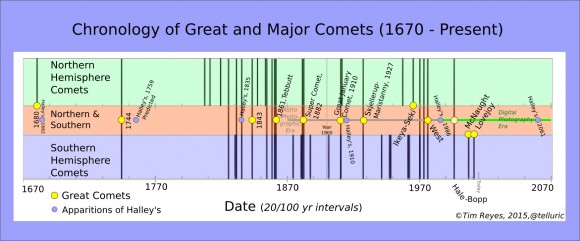
On average, every five years, ane can expect to see a major comet visible from the Earth. Nevertheless, the variability around that average is as well about five years (one standard deviation).
This ways that, on average, a major comet arrives every v to x years.
Sometimes the visitations are clustered. A prime instance is the years 1910 and 1911, when four major comets crossed the heaven.
The data also reveal that great comets arrive on average every 20 years. The variability is ten years, every bit represented by a standard deviation around the average. So truly cracking comets may be visible from Earth every 20 to xxx years. Some centuries might have two or three (1800s) while others, four or more (1900s).
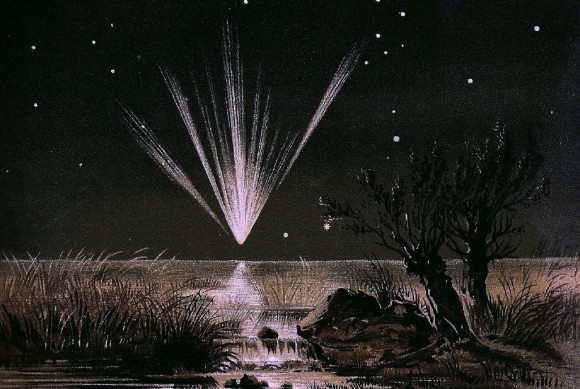
Statistically, bookkeeping for comet activity over 250 years – 38 major comets – is pretty thin data, but 1 tin can see in the plot a historic trend. It is possible that if data could reveal a leaning towards one hemisphere, information technology could exist an indicator that the Oort Cloud north or south of the ecliptic plane was affected past some object, due east.g. a passing star. At that place is no indication of this in the records.
Does it answer the question? Has the Northern Hemisphere missed out on great comets?
In that location is certainly a recent trend towards the Southern Hemisphere for great comets. The data reveal that the long-term trend for both the Southern and Northern Hemispheres is a dandy comet every 25 to xl years.
But, if you discount Hale-Bopp, then the concluding great comet for the Northern Hemisphere was Comet West, 44 years ago. Even if you consider Hale-Bopp as neat, 23 years take passed.
Information technology would seem that the northward is statistically ready to receive its adjacent great comet. Bring it on!
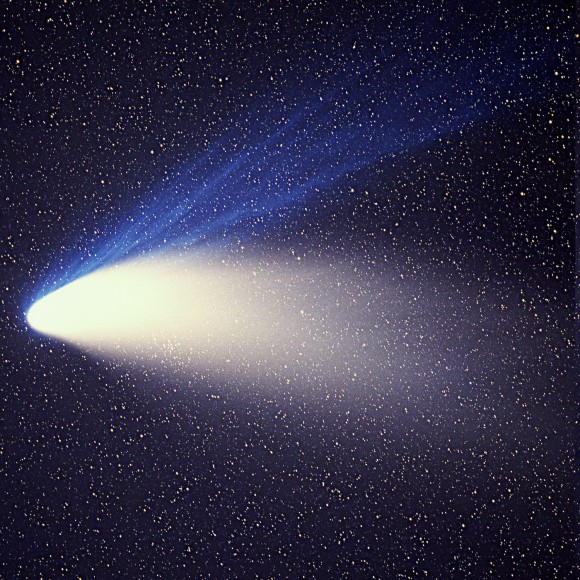
Lesser line: The Southern Hemisphere has had two corking comets in this century: McNaught in 2007 and Lovejoy in 2011. Simply what about the Northern Hemisphere? Our terminal widely seen comet was Unhurt-Bopp in 1996-97. Comet West in 1976 was probably our last great comet. We're due for one!
Read more than and run into charts: How to see Comet NEOWISE
Source: https://earthsky.org/space/northern-hemisphere-overdue-for-a-great-comet/
0 Response to "When Will Hale Bopp Comet Be Visible on Earth Again"
Post a Comment